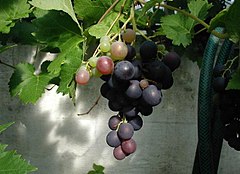Vitis vinifera
| Vitis vinifera | |
|---|---|
 |
|
| Scientific classification | |
| Kingdom: | Plantae |
| (unranked): | Angiosperms |
| (unranked): | Eudicots |
| (unranked): | Rosids |
| Order: | Vitales |
| Family: | Vitaceae |
| Genus: | Vitis |
| Species: | V. vinifera |
| Binomial name | |
|
Vitis vinifera L. |
|
| NCBI genome ID | 401 |
|---|---|
| Ploidy | diploid |
| Genome size | about 500 Mb |
| Number of chromosomes | 19 pairs |
| Year of completion | 2008 |
| Sequenced organelle | plastid |
Vitis vinifera (common grape vine) is a species of Vitis, native to the Mediterranean region, central Europe, and southwestern Asia, from Morocco and Portugal north to southern Germany and east to northern Iran. There are currently between 5,000 and 10,000 varieties of Vitis vinifera grapes though only a few are of commercial significance for wine and table grape production.
It is a liana growing to 35 yards (32 m) in length, with flaky bark. The leaves are alternate, palmately lobed, 5–20 cm (2.0–7.9 in) long and broad. The fruit is a berry, known as a grape; in the wild species it is 6 mm (0.24 in) diameter and ripens dark purple to blackish with a pale wax bloom; in cultivated plants it is usually much larger, up to 3 cm (1.2 in) long, and can be green, red, or purple (black). The species typically occurs in humid forests and streamsides.
The wild grape is often classified as V. vinifera subsp. sylvestris (in some classifications considered Vitis sylvestris), with V. vinifera subsp. vinifera restricted to cultivated forms. Domesticated vines have hermaphrodite flowers, but subsp. sylvestris is dioecious (male and female flowers on separate plants) and pollination is required for fruit to develop.
The grape is eaten fresh, processed to make wine or juice, or dried to produce raisins. Cultivars of Vitis vinifera form the basis of the majority of wines produced around the world. All of the familiar wine varieties belong to Vitis vinifera, which is cultivated on every continent except for Antarctica, and in all the major wine regions of the world.
...
Wikipedia
